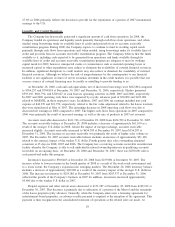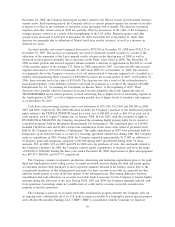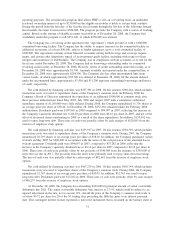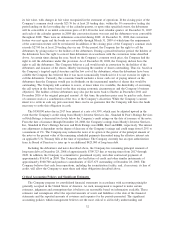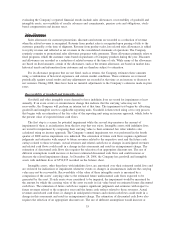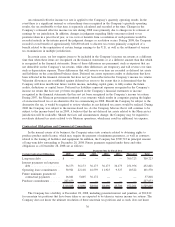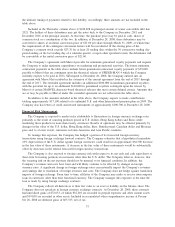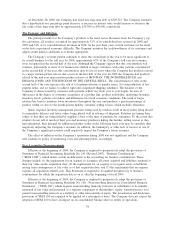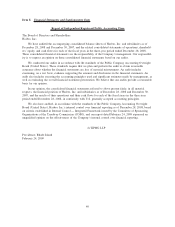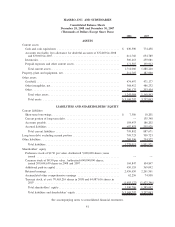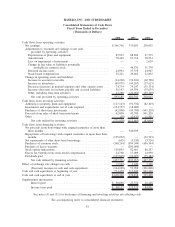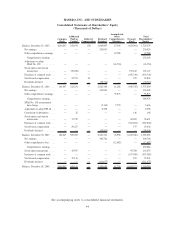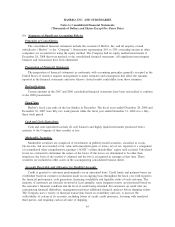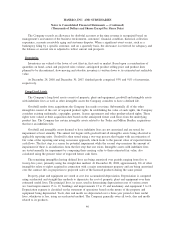Hasbro 2008 Annual Report Download - page 48
Download and view the complete annual report
Please find page 48 of the 2008 Hasbro annual report below. You can navigate through the pages in the report by either clicking on the pages listed below, or by using the keyword search tool below to find specific information within the annual report.
At December 28, 2008, the Company had fixed rate long-term debt of $709,723. The Company estimates
that a hypothetical one percentage point decrease or increase in interest rates would increase or decrease the
fair value of this long-term debt by approximately $34,300 or $30,900, respectively.
The Economy and Inflation
The principal market for the Company’s products is the retail sector. Revenues from the Company’s top
five customers, all retailers, accounted for approximately 52% of its consolidated net revenues in 2008 and
2007 and 53% of its consolidated net revenues in 2006. In the past three years certain customers in the retail
sector have experienced economic difficulty. The Company monitors the creditworthiness of its customers and
adjusts credit policies and limits as it deems appropriate.
The Company’s revenue pattern continues to show the second half of the year to be more significant to
its overall business for the full year. In 2008, approximately 63% of the Company’s full year net revenues
were recognized in the second half of the year. Although the Company expects that this concentration will
continue, particularly as more of its business has shifted to larger customers with order patterns concentrated
in the second half of the year, this concentration may be less in years where the Company has products related
to a major motion picture release that occurs in the first half of the year. In 2008 the Company had products
related to the mid-year major motion picture releases of IRONMAN, THE INCREDIBLE HULK and
INDIANA JONES AND THE KINGDOM OF THE CRYSTAL SKULL. The concentration of sales in the
second half of the year increases the risk of (a) underproduction of popular items, (b) overproduction of less
popular items, and (c) failure to achieve tight and compressed shipping schedules. The business of the
Company is characterized by customer order patterns which vary from year to year largely because of
differences in the degree of consumer acceptance of a product line, product availability, marketing strategies,
inventory levels, policies of retailers and differences in overall economic conditions. The trend of larger
retailers has been to maintain lower inventories throughout the year and purchase a greater percentage of
product within or close to the fourth quarter holiday consumer selling season, which includes Christmas.
Quick response inventory management practices being used by retailers result in more orders being placed
for immediate delivery and fewer orders being placed well in advance of shipment. Retailers are timing their
orders so that they are being filled by suppliers closer to the time of purchase by consumers. To the extent that
retailers do not sell as much of their year-end inventory purchases during this holiday selling season as they
had anticipated, their demand for additional product earlier in the following fiscal year may be curtailed, thus
negatively impacting the Company’s revenues. In addition, the bankruptcy or other lack of success of one of
the Company’s significant retailers could negatively impact the Company’s future revenues.
The effect of inflation on the Company’s operations during 2008 was not significant and the Company
will continue its policy of monitoring costs and adjusting prices, accordingly.
New Accounting Pronouncements
Effective at the beginning of 2009, the Company is required to prospectively adopt the provisions of
Statement of Financial Accounting Standards No. 141 (Revised 2007), “Business Combinations”,
(“SFAS 141R”), which makes certain modifications to the accounting for business combinations. These
changes include (1) the requirement for an acquirer to recognize all assets acquired and liabilities assumed at
their fair value on the acquisition date; (2) the requirement for an acquirer to recognize assets or liabilities
arising from contingencies at fair value as of that acquisition date; and (3) the requirement that an acquirer
expense all acquisition related costs. This Statement is required to be applied prospectively to business
combinations for which the acquisition date is on or after the beginning of fiscal 2009.
Effective at the beginning of 2009, the Company is required to prospectively adopt the provisions of
Statement of Financial Accounting Standards No. 160, “Noncontrolling Interests in Consolidated Financial
Statements”, (“SFAS 160”) which requires noncontrolling (minority) interests in subsidiaries to be initially
measured at fair value and presented as a separate component of shareholders’ equity. Current practice is to
present noncontrolling interests as a liability or other item outside of equity. The presentation and disclosure
provisions of SFAS 160 are required to be applied on a retrospective basis. The Company does not expect the
adoption of SFAS 160 to have an impact on its consolidated balance sheet or results of operations.
38



